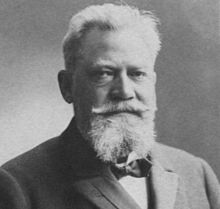Lars Magnus Ericsson
Lars Magnus Ericsson ( pronunciation : [ ˌlɑːʂ ˌmaŋːnɵs ˈeːɹiksɔn ], * May 5, 1846 in Värmskog , ( Värmland ); † December 17, 1926 in Botkyrka , ( Stockholm County )) was a Swedish inventor and founded the Ericsson company in 1876 .
Life
Ericsson grew up in the small town of Vegerbol between Karlstad and Arvika . When he was 11 years old, his father passed away and Ericsson was forced to work. He worked as a railroad and mine worker in both Sweden and Norway . In 1867 he moved to Stockholm and started working for Öller & Co., who mainly manufactured telegraph equipment. After six years, he received a scholarship based on his skills to continue his education abroad. He traveled to Switzerland and Germany , where he worked for Siemens & Halske , among others .
When he returned to Sweden in 1876, he and a colleague from Öller & Co, Carl Johan Andersson , founded a small mechanics workshop. This was located in a former kitchen on approx. 13 m² at Drottningsgatan 15 in central Stockholm. In the beginning they were engaged in the manufacture of mathematical and physical instruments, but soon began to manufacture their own variant of telephones . In 1883 he started working with Henrik Tore Cedergren , founder of Stockholms allmänna telefonaktiebolag , and Ericsson's company began to grow rapidly and became what is now Telefon AB LM Ericsson . In 1900, Lars Magnus Ericsson retired from the company at the age of 54. He kept his shares until he sold them all in 1905.
It is said that Ericsson was a difficult person and didn't like the public around him. He was very respected by his employees. He was an opponent of patents because many of the company's products would not have been possible with effective patent legislation. He didn't care when a Norwegian company built his phone because his own was largely a replica of Siemens' . If the legislation had been more effective, Bell could have patented the phone around the world, which was no longer possible. At first, Ericsson didn't think many people might be interested in owning their own phone; he saw it more as a toy for the upper class .
- Private
Ericsson was married to Hilda Ericsson , b. Simonsson (1860-1941). He was the son of Erik Eriksson (1804-1859) from Vegerbol, Värmskog and Maria Jonsdotter (1810-1859) from Mosterud, Stavnäs.
death
Lars Magnus Ericsson died in 1926 and was buried in Hågelby gård in Botkyrka, south of Stockholm. According to his wish, his grave has no tombstone .
His board room was built true to the original in the Technical Museum in Stockholm and can be viewed there.
literature
- K. Jäger, F. Heilbronner (ed.): Lexikon der Elektrotechniker , VDE Verlag, 2nd edition from 2010, Berlin / Offenbach, ISBN 978-3-8007-2903-6 , p. 119
Web links
- Tekniska Museet: Lars Magnus Ericsson
| personal data | |
|---|---|
| SURNAME | Ericsson, Lars Magnus |
| BRIEF DESCRIPTION | Swedish inventor and the founder of the Ericsson company |
| DATE OF BIRTH | May 5, 1846 |
| PLACE OF BIRTH | Värmskog ( Värmland ) |
| DATE OF DEATH | December 17, 1926 |
| Place of death | Botkyrka |

